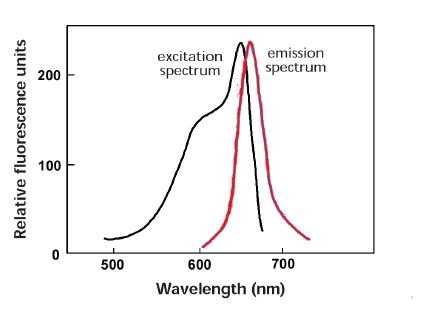Allophycocyanin Labeling Kit - NH2

Antibody / Protein Labeling
- Only 1 hour to recover conjugates
- All processes in a single filtration tube
- High recovery of conjugates
- Applicable for 50-200 μg IgG
-
Product codeLK21 Allophycocyanin Labeling Kit - NH2
| Unit size | Price | Item Code |
|---|---|---|
| 3 samples | $496.00 | LK21-10 |
| 3 samples | ・NH2-Reactive Allophycocyanin ・WS Buffer ・Reaction Buffer ・Filtration Tube |
3 tubes 4 ml x1 200μlx1 3 tubes |
|---|
Description
Phycobiliproteins are fluorescent proteins derived from cyanobacteria and eukaryotic algae. Their fluorescence is much higher than chemical fluorescent probes such as fluorescein and rhodamine. Allophycocyanin (APC) is one of the phycobiliproteins, and it has a red fluorescence at around 660 nm (Fig. 1). Because of this high fluorescence, phycobiliprotein-labeled antibodies and other molecules can provide greater sensitivity in flow cytometry and immunostaining. Allophycocyanin Labeling Kit-NH2 is for simple and rapid preparation of APC-labeled IgG (Fig. 2). NH2-reactive APC (a component of this kit) has an activated ester group and can easily make a covalent bond with an amino group of the target molecule without any activation process. The filtration tube in this kit is used for buffer exchange and concentration of sample IgG solution. This kit contains all the reagents necessary for APC labeling including the storage buffer for conjugates.

Fig. 1 Fluorescence spectrum of APC
Excitation wavelength: 650 nm
Emission wavelength: 660 nm

Fig. 2 IgG labeling reaction of NH2-reactive APC
Precaution
♦ The molecular weight of the protein to be labeled with this kit should be greater than 50,000.
♦ IgG or allophycocyanin-conjugated IgG is always on the membrane of the filtration tube during the labeling process.
♦ If the IgG solution contains other proteins with molecular weight greater than 10,000, such as BSA or gelatin, purify the IgG solution before labeling allophycocyanin with this kit.
♦ If the IgG solution contains small insoluble materials, centrifuge the solution and use the supernatant for the labeling.
| Developer | Dojindo Molecular Technologies, Inc. |
|---|
Manual
References
1) H. Shinohara, T. Yasuda, Y. Aiba, H. Sanjo, M. Hamadate, H. Watarai, H. Sakurai and T. Kurosaki, "PKCβ Regulates BCR-mediated IKK Activatioin by Facilitating the Interaction between TAK1 and CARMA1", J. Exp. Med., 2005, 202(10), 1423.
2) E. Grace Suto, Y. Mabuchi, N. Suzuki, K. Suzuki, Y. Ogata, M. Taguchi, T. Muneta, I. Sekiya and C. Akazawa, "Prospectively isolated mesenchymal stem/stromal cells are enriched in the CD73+ population and exhibit efficacy after transplantation", Sci. Rep.., 2017,(7), 4838.
3) H. Fujii, Y. Ikeuchi, Y. Kurata, N. Ikeda, U. Bahrudin, P. Li, Y. Nakayama, R. Endo, A. Hasegawa, K. Morikawa, J. Miake, A. Yoshida, K. Hidaka, T. Morisaki, H. Ninomiya, Y. Shirayoshi, K. Yamamoto, I. Hisatome, "Electrophysiological properties of prion-positive cardiac progenitors derived from murine embryonic stem cells", Circ. J.., 2012,76, (12), 2875.
Q & A
-
Q
Can I use this kit for other proteins?
-
A
Yes, if the molecular weight is higher than 50,000 and it has a reactiveprimary or secondary amino group. Follow the protocol for IgG labeling with 0.5-1 nmol of sample protein.
-
Q
How many APC molecules per IgG are introduced?
-
A
The average number of APC molecule per IgG is 1 to 2.
-
Q
Does unconjugated NH2-reactive APC still have an activated ester after the labeling reaction to IgG??
-
A
No. It is completely hydrolyzed during the reaction.
-
Q
Does NH2-reactive APC form an oligomer during the labeling reaction?
-
A
No. Since all amino groups of NH2-reactive APC are blocked, no oligomerization is possible.
-
Q
What is the minimum amount of IgG that can be labeled with LK21?
-
A
The minimum amount is 50 μg. There is no significant difference in sensitivity and background between 50 μg and 200 μg of IgG.
-
Q
Do I have to use the WS buffer included with the kit?
-
AYes. Use the WS buffer to prepare a stock solution of the conjugate. However, you can choose any kind of buffer appropriate to dilute the conjugate stock solution for your experiment.
-
Q
How long is the conjugate stable?
-
A
If you store at 4ºC, it is stable for over 2 months. For longer storage, add 100% volume of glycerol, aliquot and store at -20ºC. However, please note that the stability depends on the protein itself.
Handling and storage condition
| 0-5°C, Protect from moisture |












